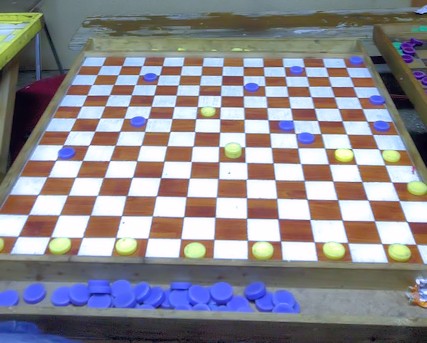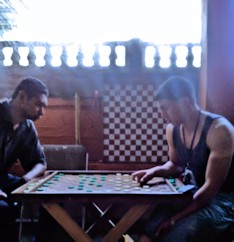
A South African 14 x 14 draughts board. (Photo by Zubair, Cape Town.)

A South African 14 x 14 draughts board. (Photo by Zubair,
Cape Town.)
These traditional variants of checkers have rules similar to Dame
(International draughts), in which pieces are allowed to capture backwards.
Dames (Kings) are “long” (i.e., can slide and jump any number
of squares). The following variants have been implemented.
International Draughts (Polish draughts) is played on a 10 x 10 board
with 20 pieces per player. The object is to capture all your
opponent’s men by jumping over them, or stalemate the opponent so he
has no moves. A Man can move forward, by sliding diagonally to an adjacent
empty square. It may also jump over an enemy piece in any direction to a
vacant square on the other side. Jumping over a piece captures it.
Capturing is mandatory, and you must keep jumping and capturing as long as
it is possible. You must even choose beforehand the series of jumps that
captures the most men. When your Man reaches the other end of the board, it
becomes a Dame and can then move and capture forwards and backwards over
any distance. It also jumps to capture, but only one Man at a time. A Dame
must also choose the line that makes the most captures.
Dam Lombok (Breakthrough) is played in Indonesia and has also
achieved some popularity in the Netherlands. Same as International
Draughts, except that win is also achieved by becoming the first to promote
a Man to King.
Canadian Checkers (or Canadian draughts) uses the same rules as
International draughts, but the game is played on a 12 x 12 board with 30
pieces per player. Canadian Checkers was invented by the French settlers of
Quebec, Canada. It was originally named Grand jeu de dames. It is
unknown when the game was first played in Canada. The idea of an
increased-size international draughts game is older still; boards with
12 x 12 squares were on sale in London in 1805 (cf. Wikipedia).
Sri Lankan Checkers (or Lankesian draughts) is the same as Canadian
Checkers, except that the board is mirrored.
Sri Lankan Dām is unique, because a Man can also move
backwards. Capture is mandatory, but it is not mandatory to capture the
longest line. Play occurs on the white squares. Board is 12 x 12.
Dumm (or “long draughts”) is played in South Africa.
Dumm uses the same rules as International draughts but is played on a 14 x 14
board with 42 pieces per player. It is still played in Cape Town. (However,
the old huff rule is not implemented here.)

Players of “Dumm”. (Photo by
Zubair.)
Damii (Ghanaian draughts) is similar to International Draughts
(board size 10 x 10). However, although capture is mandatory, it is
not mandatory to capture the longest line (i.e. it is not necessary
to choose the series of jumps that captures the most men). Board is
mirrored. In Ghana, players use the huff rule, but this is not implemented
here. Play is very fast-paced. A notable exception to the standard rules is
that the player who has only one piece left (king or checker) loses. This
makes the game less drawish.
Nigerian Checkers (draughts) is the same as Damii, except that the
single piece rule is not used.
Brazilian Checkers (Minor Polish draughts) is related to Dame
(International Draughts), but played on an 8 x 8 board with 12 pieces per
player. If a Man makes an intermediate landing on a promotion square and
can continue capturing, it is not promoted. This variant was known already
in the 16th century, and possibly even earlier. It was a popular board game
in Holland, especially in Amsterdam.
Philippine Checkers is the same as Brazilian checkers except that
the board is mirrored. Players from Luzon, Panay, and part of Mindanao,
play on the mirrored board. However, according to the World Dama
Federation, it should be played on the regular board (same as Brazilian
checkers.)
Pool Checkers is similar to International draughts, but is played on
an 8 x 8 board. Although capture is mandatory, it is not mandatory to capture
the longest line (i.e. it is not necessary to choose the series of jumps
that captures the most men). A Man promotes at the farthest rank, but is
not promoted if capture continues. It is the same as Northern German
checkers, which is played on a mirrored board. The first book covering
German Draughts was the 155-page folio volume “Die unterschiedlichen
Spiel- und Vorstellungen des weltberühmten Damspiels”, which was
published around 1700 in Nuremberg by Johann Wolfgang Schmidt
(cf. checkers.wikia.com). In America, where it acquired the name Pool
Checkers, this variant has its own organization; the American Pool Checkers
Association (APCA).
Jamaican Checkers (Northern German checkers) corresponds to Pool
checkers. The only difference is the mirrored board. Jamaica is an island
country situated in the Caribbean Sea. In 2013 the population was 2.715
million. A German population was established in Jamaica in the 1830’s
and some German words have entered the Jamaican vernacular (cf. Wikipedia).
Northern Slovakian Checkers is the same as Pool checkers except that
there are only eight pieces per player.
Russian Checkers (“Russkie Shashki”) is the
same as Pool Checkers, except that a Man is promoted to Dame during a
capture sequence, if it makes an intermediate landing on a promotion
square. Although capture is mandatory, it is not mandatory to capture the
longest line. This variant is played in Russia, former Eastern Bloc
countries, and in Israel. The International Draughts Federation (IDF) has
adopted the name “Draughts-64” for all 8 x 8 variants.
Spantsiretti is the same as Russian Checkers, except that it is
played on a 10 x 8 board.
Laotian Checkers follows the same rules as International Draughts
(board size 10 x 10), except that it is not mandatory to capture the longest
line.
Ivorian/Paraguayan is the same as International Draughts (board size
10 x 10), except that the board is mirrored.
Swazi Checkers is played in Swaziland, officially the Kingdom of
Eswatini. A Man can promote to Dame during a capture sequence. It is
mandatory to capture the longest line. Pieces are immediately
removed. However, a Dame cannot reverse capture direction. Board size
is 8 x 8.
Romanian Checkers is the same as Brazilian Checkers, except that a Man will promote to Dame during a capture sequence (if it makes an intermediate landing on a promotion square). It is mandatory to capture the longest line. Board size is 8 x 8.
Note! I also introduce variants with a special rule that serves to
reduce drawishness: the Dame must stop on the first vacant square after the
last captured piece, if and only if that piece is also a Dame. Thus, two
Dames will always win against one Dame. I believe this is a significant
improvement, especially for the 8 x 8 variants. This rule is fetched from
Killer draughts,
which is also included.
References
Ratrout, S. ‘A Guide to Checkers Families and Rules’.
(Academia.edu, here)
Canadian Checkers:
http://en.wikipedia.org/wiki/Canadian_Checkers
http://www.checkerslounge.com/canadian-checkers.html
http://www.checkershistory.com/Canadian-Checkers-Variant.html
http://dames.quebecjeux.org/en/ (here is also a
game database with Canadian Checkers games.)
Ghanaian draughts:
http://en.wikipedia.org/wiki/Draughts
http://www.scribd.com/doc/22308031/Damii-Ghana-Draughts-History-
Rules#scribd
Nigerian checkers:
http://www.draftstechniques.com/
International (Polish) Draughts:
http://en.wikipedia.org/wiki/International_draughts
Lankesian draughts:
http://windames.free.fr/srilankan.html
Brazilian checkers:
http://fmjd64.org/rules-of-the-game/
http://en.wikipedia.org/wiki/Brazilian_draughts
http://www.checkershistory.com/brazilian-checkers-variant.html
http://goldtoken.com/games/play?rules=CheckersBraz
http://www.checkerslounge.com/brazilian-checkers.html
http://windames.free.fr/brazilian.html
Minor Polish draughts:
http://www.draughtshistory.nl/polish.htm
Pool Checkers and Northern German checkers:
http://checkers.wikia.com/wiki/Deutsches_Damespiel
http://www.americanpoolcheckers.us/index.php/history/apca-tournament-rules-of-play
Philippine checkers (Dama):
http://filipinodama.webs.com/factsaboutdama.htm
Jamaican checkers:
http://oshanedraughts.webs.com/
http://jamaicandraught.ucoz.com/
Sri Lankan Dām:
Parker, H. (1909).
Ancient Ceylon, p.584.
Dumm (South African draughts):
https://www.fmjd.org/downloads/variants/Checkers_families_and_rules_28-9-2018.pdf
Russian Checkers:
http://fmjd64.org/
http://www.checkerschest.com/checkers-games/russian-checkers.htm
http://checkers.wikia.com/wiki/Russkie_Shashki
http://en.wikipedia.org/wiki/Russian_draughts
Romanian Checkers:
https://ioana-stamatiade.blogspot.com/2014/11/dame-checkers.html
☛ You can download my free Checkers Variants program
here (updated 2024-01-29), but you
must own the software Zillions
of Games to be able to run it. (I recommend the download version.)
☛ See also Frisian draughts
☛ See also Spanish Checkers Variants
☛ See also Gothic Checkers Variants
© Mats Winther (Feb 2015).